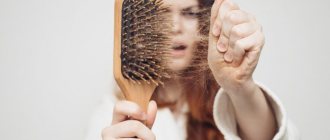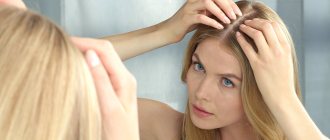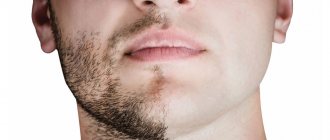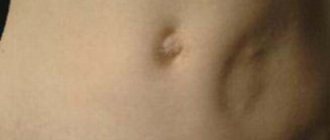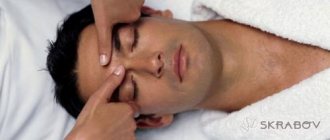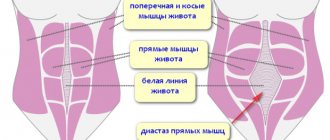Baldness in men occurs at any age, but before age-related changes begin at 45-50 years old, it becomes a serious cause for concern. The presence of hair reflects the condition of the entire body, so premature baldness requires diagnosis, identification of specific causes in order to exclude hormonal, immune or other diseases.
What is alopecia
Alopecia (from Latin alopecia “baldness, baldness”) is pathological hair loss, which leads to its disappearance on the head or body. Under normal conditions, the hair on the head consists of 100-150 thousand hairs, which are distributed with a density of 200-400 pcs/sq.cm.
The life development of hair occurs in a cyclical manner.
- Anagen is the stage of growth, active division of epidermal cells and melanocytes that produce melanin. Cell division increases pressure inside the hair follicle and leads to keratinization (keratinization) of the tissue. The hair follicles are nourished through the blood vessels in the hair papilla.
Together with the blood, hormones (androgens) also enter the follicles, lengthening the stage of active growth. Hair is one of the fastest growing tissues in the human body. Up to 80% of hair shafts are in this stage; it lasts 4-5 years.
- Catagen is a transitional stage when cell division gradually stops and the hair follicle shrinks. The hair papilla atrophies, so cells without incoming nutrition stop dividing.
- Telogen is the stage of rest and death, the hair follicle separates from the hair papilla and gradually moves to the surface of the skin. And around the hair papilla, another hair follicle begins to form so that the process of hair germination resumes. 50-150 hairs fall out per day; episodic hair loss is possible with intensive use of styling products or combing.
If there is noticeable hair loss or thinning, or the appearance of individual bald spots, you should contact a trichologist for a detailed diagnosis. Several types of alopecia are most common.
- Androgenic – male-pattern baldness, thinning, hair loss in the frontal and parietal region with further spread to the entire head. This is the most common case of alopecia, affecting more than 90% of balding men.
- Diffuse (symptomatic) - uniform hair loss throughout the head due to a disruption in the cycle of hair development and growth. It manifests itself as a result of deviations in the functioning of the whole organism, therefore it is also called symptomatic.
- Cluster (focal) – hair loss due to damage to the cells of the root system by the immune defense. Manifests itself in the form of one or several limited areas of baldness.
- Scarring is irreversible damage to the hair follicles at the site of the scars, where connective tissue scars have formed.
Trichotillomania (traumatic alopecia) is caused by mechanical hair pulling, sometimes as a result of obsessive-compulsive disorder. Such cases are treated together with a neurologist and psychotherapist.
Alopecia due to ringworm, psoriasis, seborrhea, various dermatitis or autoimmune diseases is treated as a result of complex therapy of the underlying disease.
Androgenetic alopecia
Typically, “male” baldness is caused by androgens - these are steroid hormones responsible for secondary sexual characteristics in men. Androgens act through the cells of the hair papilla, which is an intradermal area with capillaries and nerves that nourishes the hair follicles. Inside the hair papilla, androgens influence receptors on which paracrine factors depend.
Testosterone in the composition of androgens enters the cells of the root zone, where, under the influence of a special enzyme, it is converted into dihydrotestosterone. This slows down or stops the release of substances necessary for the division of hair stem cells and the normal state of the extracellular matrix. The lack of paracrine factors leads to a stop in the reproduction of follicles and hair germination.
The skin becomes thinner and drier as blood flow and oxygen supply are reduced. The follicles end up at a depth of up to 1 mm and do not receive the necessary nutrition. Whereas in their usual form they are adjacent to the choroid and nerve plexuses at a depth of 3-4 mm.
The hair on the head gradually becomes thinner and shorter, loses its natural color, barely noticeable bald patches expand, and in a few months of years they can transform a person beyond recognition. Over 8-10 years, the mouths of the follicles are completely blocked by connective tissue, and even the appearance of vellus hair stops.
Diffuse alopecia
There are various forms of diffuse alopecia:
- anagen – occurs when there is a negative effect on the body, when hairs fall out at the anagen stage, which is provoked by dangerous factors (poisoning with poisons, radiation exposure, chemotherapy).
- telogen - hair follicles fall out prematurely at the telogen stage and stop reproducing new hair, this can happen for many reasons (hormonal imbalances, nervous stress, exacerbation of infectious diseases, long-term treatment with antibiotics, antidepressants or other medications), diets or poor nutrition also lead to lack of vitamins and minerals and cause diffuse baldness.
After the cessation of the harmful effects of diffuse alopecia, the normal condition of the hair is restored within a year. After eliminating the cause, stimulants are used for their faster growth.
Alopecia areata
It has different stages of manifestation according to the number of affected areas: subtotal, total and universal alopecia. In the final stages, hair loss begins throughout the body, which indicates the systemic development of an autoimmune disease.
With the active entry of genes that ensure immunological compatibility, protein compounds are produced that provoke changes in the immune system. This can be affected by viral diseases, vaccinations, nervous stress, and various medications.
To treat alopecia areata, corticosteroids are used in various forms (tablets, injections, ointments). The drug 1-Chloromethylsilatrane and a similar cosmetic drug Mival are registered in the Russian Federation; the American drug Minoxidil is often used. In addition, treatment is carried out with Anthralin (a nonspecific immunomodulator), retinoids (structural analogues of vitamin A).
Scarring alopecia
It occurs as a result of irreversible damage to the skin due to infections of various etiologies, traumatic or surgical effects. Any deep wound or burn leaves scars, at the site of which, due to the connective tissue, hair growth stops. To eliminate local baldness, a surgical method is used: either the affected area is removed, or healthy follicles are transplanted to this place.
Hereditary baldness in men
Hereditary baldness in men can be simplistically described as follows:
- Inside the hair follicle of the parietal or frontal zone, under the influence of a specific enzyme, the male sex hormone testosterone is converted into the active hormone dihydrotestosterone.
- DHT begins to affect the hair follicles, causing a spasm of the supplying vessels.
- Protein synthesis is disrupted, resulting in dystrophy, reduction in hair length, and shortening of the growth phase of the hair shaft.
Main causes of baldness
Based on the factors that lead to various types of alopecia, the most significant causes of hair loss can be named:
- genetic - according to the observations of specialists, 80-90% of men “inherit” baldness, so ointments and injections do not help;
- medical – as a result of hormonal, immune, infectious or other diseases, when using medications, after exposure to chemotherapy;
- behavioral - our body reacts to nutrition and lifestyle, and a “cumulative” effect appears, the body gets tired of resisting risk factors and begins to give signals that it is enough to abuse anabolic steroids, alcohol, smoking and other dubious habits.
How is the baldness gene transmitted?
Hereditary, genetic alopecia is a pathological process of active hair loss, provoked by a special baldness gene.
Scientists have traced in detail the hereditary connection between representatives of the male line of the clan. It has been noted that the baldness gene is transmitted both along the grandfather-father-son chain, and along the maternal line from mother to son. At the same time, the woman herself does not suffer from alopecia - she is only a carrier of the gene.
The scientific theory is that the Sox21 hair loss gene is passed on through generations. The following factors can activate the process of hair loss: diseases of internal organs, stress, alcohol and smoking, and unfavorable environmental conditions.
A person cannot choose whether to have the baldness gene or not. But he has the power to independently solve the problem of alopecia and prevent the development of this process in the future.
How to recognize alopecia: diagnosis and symptoms
To diagnose alopecia, the general condition of the body is checked and special techniques are used.
- Blood tests - general, biochemical, serological for infections, syphilis, transferrin and ferritin levels, adrenal and thyroid hormones.
- Skin biopsy on the scalp - a skin sample up to 4 mm in size is taken for histological examination. The presence of infectious agents, dermatoses, seborrheic keratoses, and various neoplasms are detected.
- A mineralogram is a spectral analysis of a strand up to 5 cm long, which reveals disorders of mineral metabolism. Each hair contains mineral compounds typical for the whole body, which can be used to determine a lack of necessary substances or a tendency to certain diseases (allergies, dysbacteriosis, dermatitis).
- Trichogram is a microscopic examination in which 50 hairs are removed from the head with tweezers and examined under a microscope to determine the number of anagen and telogen hairs. Examine the skin and hair around balding areas to identify the presence of fungi and parasites.
- Trichoscopy is a method of examining hair follicles at multiple magnification using a trichoscope. Based on the data obtained, it allows us to determine the density of hair per square cm, the ratio of anagen and telogen hairs, the number of viable follicles, and what stage they are in.
Phototrichogram – in addition to trichoscopy, photographs are taken. In the problem area (up to 1 sq. cm), the hair is shaved and their growth is observed after 2-3 days. Then anagen hair will grow, but telogen hair will not appear.
A special program determines the presence of vellus (dysplastic) hair, which means thinning hair shafts with a shortened life cycle. Patients with androgenic alopecia are characterized by an increased amount of telogen and vellus hair.
If necessary, you should consult an allergist, immunologist, or endocrinologist. Do allergy tests, take an immunogram, take additional hormonal tests to identify vulnerabilities in the body’s defenses.
Self-examination for alopecia
For self-diagnosis, you can use the Norwood-Hamilton baldness scale, which is used by trichologists. If the hair boundaries have moved beyond degree 2, this may indicate male pattern baldness.
- Take your previous photographs, compare them with your current state, and evaluate the changes that have arisen.
- Pay attention to the change in color; if this is not seasonal fading, then lightening and thinning of the hair confirms the presence of a problem.
- Check wet hair after a shower, when gaps and bald spots are especially noticeable.
- Look carefully in a reverse mirror or take a photograph of the crown; if it stands out noticeably and seems “thin”, then androgenic alopecia is possible.
Creating the necessary conditions for hair growth and restoration.
This is a very important component in the treatment of hereditary baldness! Follicles are very sensitive to poor blood supply and deficiency (imbalance) of certain microelements.
It is necessary to begin treatment for AGA by correcting the imbalance of microelements. Why? The follicle is a kind of hair production factory. The rate of mitosis (cell division) is very high, the highest in the entire body. Microelements, figuratively speaking, are the main raw materials for hair production. If you don’t do this and start using stimulants right away, then very soon the follicle will become depleted. The hair will go into telogen. The effectiveness of using the stimulant will drop to zero, and regression will begin.
To correct an imbalance of microelements, you can contact us, or you can contact the Moscow Center for Biotic Medicine (www. microelements. ru). Correction of microelementosis is best done with second-generation monomedicines (aspartates, chelates).
With AGA, not only the follicles are affected, but also all skin appendages, including capillaries and precapillaries, and not only blood vessels, but also lymphatic ones. Poor lymphatic drainage leads to tissue swelling, accumulation of toxins, etc. Inadequate blood supply leads to oxygen starvation, and this is acidification of tissues, an anaerobic type of respiration. To improve blood supply to the scalp, I use trichological massage, infrared laser, and Darsonval currents.
It is necessary to improve blood properties and transport function. In this regard, it is necessary to saturate the body with iron, vitamin B12, and cobalt. It is very important to carry out antioxidant therapy, biostimulation, and enterosorption during the treatment process. During the entire treatment period, the patient should receive up to forty mg of zinc aspartate (5 mg of pure zinc) per day.
Plasma therapy (PRP - platelet rich plasma) or autologous cellular (platelet) rejuvenation of the scalp.
As a result of a course of plasma therapy, hair loss is reduced, because a powerful regenerative process is launched, hair follicles are strengthened, the functioning of the sebaceous glands is normalized, and dandruff, itching and dryness of the scalp are eliminated, the cross-section and fragility of the hair shaft is reduced, the diameter and density of the hair increases, returning hair elasticity and shine. It is better to carry out the procedures once every seven to fourteen days; the course involves 4 to 10 procedures.
How can you cure alopecia?
If the cause of baldness is due to extraneous factors (stress, treatment programs with antibiotics and other drugs, radiation, poisoning), then first of all it is necessary to eliminate the negative effects on the body and use stimulants for hair growth. And if the reason is androgenic factors, then hormonal therapy or hair transplantation can be used.
Hormonal drugs
Testosterone, entering the hair follicles, is converted by the enzyme 5-alpha reductase into dihydrotestosterone (DHT), which causes hair loss. This means that it is necessary to reduce the manifestation of DHT and limit the action of these enzymes.
- Finasteride is a hormonal drug, a synthetic selective blocker of 5-alpha reductase proteins. Effectively reduces both free DHT and that found in tissues.
- Analogs: Alfinal, Zerlon, Proscar, Prosteride, Urofin, Finast in tablets, 5 mg of active ingredient.
Men also experience menopause, which leads to hormonal changes in the body. The gonads begin to reproduce hormones in smaller quantities, which are necessary for the full functioning of the body. The skin and hair are the first to suffer, wrinkles and age spots appear.
Nature seems to save on what is less significant and tries to preserve the normal state of internal organs and systems and reproductive abilities for a longer period. Therefore, there is now a growing trend to prescribe hormone replacement therapy to men aged 40-45 years in order to balance the amount of testosterone and other hormones.
- Hormonal agents: Andriol, Testosterone propionate, Sustanon 250 and others, Androgel for external use.
Attention! Gradual baldness with age does not surprise or frighten anyone. But if a man begins to suddenly lose his hair in clumps, or his receding hairline has noticeably increased in a short period of time, he should immediately undergo a comprehensive diagnosis. This may be a sign of hormonal imbalance, prostate adenoma and other neoplasms.
Immune drugs
If the causes of alopecia depend on the immune system, then tablets, injections, and topical preparations may be prescribed.
Researchers at the University of Manchester have found that an immunosuppressant drug designed to prevent organ rejection can treat alopecia. This is cyclosporine-A, which can stimulate the growth of hair loss.
However, this medicine is of little use due to multiple side effects, so experts have identified another compound: WAY-316606, which is even more effective. The drug has passed laboratory tests and is now awaiting clinical testing.
Glucocorticosteroids (GCS) are steroid hormones from the subclass of corticosteroids secreted by the adrenal cortex. They exhibit anti-inflammatory, antiallergic and immunosuppressive properties.
- Short-acting corticosteroids: Budesonide, Hydrocortisone, Clobetasol, Mazipredone, Mometasone, Cyclesonide, Flunisolide, Fluticasone.
- GCS with moderate action: Prednisolone, Methylprednisolone, Triamcinolone, Fludrocortisone.
- Long-term corticosteroids: Beclomethasone, Betamethasone, Dexamethasone, Diprospan, Celestoderm.
Immunomodulators are necessary in the treatment of alopecia areata, which occurs against the background of autoimmune diseases:
- Inosiplex
- Isoprinosine
- Levamisole
- Timopentin
Anti-anxiety medications
For nervous and mental disorders, sedatives with a sedative effect are used.
- Antidepressants - used to treat depression, affect the level of neurotransmitters (dopamine, serotonin, norepinephrine). They lift your mood, reduce anxiety, anxiety, irritability, and stimulate mental activity.
- Tranquilizers are psychotropic drugs that help relieve anxiety and fear.
- Nootropics – improve all mental functions, activate mental abilities.
Local preparations and hair growth stimulants
Growth stimulants are used directly for the scalp, which restore intercellular metabolism and saturate the follicles with necessary substances.
- Minoxidil (Alerana, Generalolon, Loniten, Rogaine) is a vasodilator cosmetic for accelerated hair growth. Slows down hair loss, stimulates the “awakening” of hair follicles. Used for the treatment and prevention of androgenetic alopecia at any age.
This drug contains nitric oxide, which promotes hyperpolarization of cell membranes and improves the penetration of beneficial substances. Presumably, the effect of Minoxidil is associated with the expansion of capillaries, increased supply of oxygen and nutrients to the hair follicles.
The product is used 2 times a day, the first results can be seen after 2-3 months. Minoxidil activates hair growth, but does not remove the hormonal causes of androgenetic alopecia. Therefore, its effectiveness is limited by the period of use; experts advise taking a month's break every six months. Available in the form of tablets, gel, foam, spray, shampoo, it does not cause addiction or withdrawal symptoms.
- Follicel is a peptide cocktail with a mesotherapeutic effect to stimulate hair growth and prevent hair loss. Used for external use. It contains: inositol (vitamin B8), milk proteins, Dl-ethylpanthenol, sulfur-containing amino acids (N-acetyl-cysteine, N-acetyl-methionine).
- Fitoval Hair Loss is a lotion against hair loss, contains lauric and ximenic acids, esculin (a glucoside with an anti-inflammatory effect). The components of this product improve blood supply to the root zone and ensure the supply of nutrients. Lauric acid inhibits the activity of the enzyme 5-alpha reductase, which converts testosterone to dihydrotestosterone.
- Time to Grow is an active lotion that stimulates hair growth and contains sphingolipids (structural components of cell membranes and nuclei). It is an immunomodulator that has a positive effect on cell development.
Many cosmetology companies produce their own products to strengthen and improve hair structure: DSD, Ollin, Vichy, Kerastase.
Important! Regular shampoos serve hygienic purposes, but contain substances that can harm hair. For example: Ammonium Lauryl Sulfate, Ammonium Laureth Sulfate, Sodium Lauryl Sulfate, Sodium Laureth Sulfate. With frequent use, they disrupt the sweat-fat balance, and the hair becomes dirty much faster. Added to this are marketing techniques such as “Suitable for daily use.”
Scientific interpretation
The lack of complete information about the mechanism of development of baldness has served as fertile ground for the development of many theories. Most assumptions that are not supported by a scientific basis require further study:
Alopecia is a disease of mature men. This is a wrong assumption. The thing is that the process of alopecia, which began at the age of 20, becomes noticeable only by the age of thirty.
Important! At the slightest sign of hair loss, you should consult a doctor. In the early stages, alopecia can be successfully treated.
In 2005, German scientists discovered the baldness gene on the X chromosome (passed from mother to son). However, three years later, a similar gene was recorded in chromosomes transmitted through the paternal line. Bottom line: the baldness gene is passed on from both the mother and the father.
Frequent haircuts are a good way to prevent alopecia. Unlike beard hair, which only becomes thicker with frequent shaving, the hair on the head does not have this feature.
Frequent haircuts do not prevent early hair loss.
Prolonged stress provokes alopecia - a controversial theory. It cannot be said that stress provokes active hair loss. But nervous overstrain dramatically worsens the functioning of internal organs and systems, which affects the condition and thickness of hair.
Hair transplant
Hair transplant is the most effective method, which shows positive results in 80-90% of cases. Recognized standards for survival rate are at least 90%, which means that out of 100 transplanted hairs, 90 should grow back. The density of transplanted hair is at the level of 60-80% of the natural value (about 300 units per 1 sq. cm). Transplanted hair follicles begin to sprout within 3 months.
The International Society of Hair Restoration Surgery ISHRS distinguishes the following types of operations:
- The FUT method (Follicular Unit Transplantation) is a patchwork method; a skin flap cut from the scalp on the back of the patient’s head is used for transplantation. This flap is cut into grafts, smaller fragments, each of which contains 2-3 hair follicles. Grafts are implanted into problem areas and results are assessed within approximately 1-2 months. This method is used when transplanting a significant number of follicles, more than 10,000 (up to 5,000 grafts).
This is a fairly traumatic method, after which complications in the form of swelling and inflammation are possible. As a result of an inept operation, the transplanted hair grows in tufts and looks unnatural. Transplantation in this way can be carried out no more than 2-3 times, since the donor zone is significantly reduced.
- FUE method FUE (Follicular Unit Extraction) is seamless, more promising. Follicular groups are removed from the donor area using special instruments with a diameter of 0.6-0.8 mm. This method is not suitable for extensive baldness, when more than 3000 grafts need to be transplanted.
In addition to the back of the head, you can use the chin, chest, limbs, and groin area. After transplantation from another part of the body, the new hair on the head changes its characteristics. Hair transplanted from the chest grows longer and straighter.
The “innovative” HFE method (Hand follicul extraction) is a type of FUE, in which hair for transplantation is also taken with a punch in the form of a tube with an oblique cut, but is implanted not with tweezers, but with an implanter. However, this does not give rise to aggressive marketing and baseless claims about a unique method.
Attention! From January 1, 2020, Order of the Ministry of Health of the Russian Federation No. 804N “On approval of the range of medical services” approved the list of operations subject to licensing. This includes “Scalp hair transplantation”, “Hair follicle transplantation”, therefore cosmetology salons are required to have a license or refer to a specialized specialist.
How does baldness happen?
With androgenetic alopecia, the hair structure changes. They become shorter, thinner and lose their natural color. To understand the nature of the pathological process, you should consider how hair grows.
They arise from follicles, or structures located under the scalp. One strand of hair grows for 2-6 years. This period is called the anagen phase. Then growth stops for several months. At this point, the telogen or resting phase begins. This is followed by natural hair loss (exogen). Then the described cycle is repeated.
With androgenetic alopecia, the duration of the anagen phase is shortened. Most of the curls are at rest. Some follicles begin to reproduce new hair with some delay. As a result, bald patches form on the head.
Baldness in men goes through five stages, while in women this process takes 3. Initially, areas devoid of hair form on the temples. At the second stage, baldness is observed in the back of the head. Subsequently, the pathological process affects the parietal (third degree) and frontal (fourth degree) regions. When the fifth stage is reached, the last two parts of the head are completely hairless.
Why is oily seborrhea dangerous?
- Irina Nasredinovna Nachoeva
- September 24, 2020
In women, baldness is observed mainly in the central-parietal region (third degree in men). In addition to hair loss, androgenetic alopecia has other clinical manifestations. Depending on the severity of the disease, baldness can be:
Moderate alopecia in women is accompanied by changes occurring in the ovaries. The last stage of the disease occurs during the period before and after menopause. In women, hair is retained on the temporal and frontal areas.
Salon treatments and physiotherapy
Physiotherapeutic techniques (cryomassage, ozone therapy, darsonvalization, electrophoresis) are aimed at “revitalizing” capillary blood supply and resuming the activity of dormant follicles.
- Mesotherapy is a popular injection procedure in which a beneficial composition of vitamins and biologically active substances is injected into the scalp. The course of injections is 8-10 procedures.
- PRP therapy (plasma therapy) is also an injection method of treatment; it involves injecting a drug with platelets from the patient’s own plasma into the scalp. The course, according to practicing cosmetologists, is effective when repeated regularly; there is no data on how advisable long-term use is.
Symptoms of androgenic alopecia
The first step towards treatment is a detailed diagnosis, during which the hereditary or androgenic profile is studied. This is especially important if baldness is observed not in an adult man of old age, but in a young man, a youth. As a rule, alopecia is in no way associated with a person’s active sexual life.
Statistically, up to 16% of men under 30 years of age suffer from alopecia, the cause of which is a hereditary or androgenic factor, and up to 93% of males sooner or later encounter a similar condition. Androgenetic alopecia may be associated with genetic factors, but regardless of the reasons that led to this condition, there are a number of ways to cure the hereditary disease.
Alopecia is considered serious when a man experiences loss of more than 100 individual hairs per day. In this case, it is recommended to consult a doctor. Associated symptoms: androgen deficiency, changes in hair color and thickness, fragility and excessive hair loss when combing.
If you do not try to eliminate the problem at an early stage, the next symptoms will be the appearance of bald patches, or complete loss of hair in the forehead and crown area. How effective the treatment will be depends entirely on whether the diagnosis was made correctly and how timely the patient sought help.
Folk remedies
Hair strengthening masks most often have a warming effect to stimulate capillary blood supply. Therefore, they contain components such as mustard, red pepper, vodka or tinctures. They add softening parts in the form of fermented milk products, vegetable oils (castor, burdock).
The prepared mixture is applied for 15-20 minutes and washed off with regular shampoo; for rinsing, you can use a herbal decoction of nettle, burdock, calendula, and chamomile. The ineffectiveness of this technique against incipient baldness has been proven by the fact that “secret” recipes are constantly found on the Internet, which ultimately do not help anyone.
Many beauty bloggers promote affordable pharmaceutical products for strengthening and restoring hair: Dimexide, Panthenol, Brewer's yeast, Nicotinic acid.
Differential diagnosis
Differential diagnosis of baldness in men will help to accurately determine the type of disease. This is necessary to prescribe a course of treatment that will give the desired result in a short time. Alopecia should be distinguished from the following diseases:
- Trichotillomania. A mental disorder in which a person independently pulls out hair on his head and other parts of the body. Women are more likely to suffer from this disease. It may be accompanied by compulsive eating of plucked hair (trichophagia).
- Mycoses caused by parasitic fungi. In this case, the hair falls out, forming lesions. On loose skin, inflammatory processes and rejected dead epidermal cells are observed. Hair does not fall out at the root: it remains in the skin and its broken end is visible to the naked eye.
- Trichophytosis, or ringworm. With this disease, red, round spots appear on the scalp. They itch and cause considerable discomfort. The roots are also affected, and their loss begins from the frontal region. Sometimes dandruff occurs on the front of the head.
- Secondary syphilis. This sexually transmitted disease affects the skin and mucous membranes. Due to minor hemorrhages, hair loss begins, which can progress to complete baldness. Sometimes hair loss during syphilis is a sign of improper treatment or the use of toxic substances and drugs.
Tips from trichologists
In case of hair loss and baldness, it is necessary to promptly diagnose and begin comprehensive treatment.
- Hair is 80% composed of protein compounds (keratinocytes, fibroblasts); for normal cellular structure, proteins and amino acids are needed - the “bricks” and “mortar” in the hair structure.
- Diets and nutrition should take into account the presence of all necessary vitamins (A, B5, B6, C, E, F) and minerals (iron, magnesium, silicon, phosphorus, zinc).
- It is necessary to maintain proper head hygiene and temperature conditions, wash your hair often enough, but not every day, protect it from overheating, hypothermia, and direct sunlight.
- Use dermorollers for home mesotherapy to achieve maximum penetration of drugs into the skin. Microscopic punctures of the skin increase the absorption of nutrients in the deeper layers of the epidermis. Improves blood microcirculation, stimulates the production of your own collagen.
- Use head massagers: the most common roller ones, studded ones, more “advanced” ones. For example, compression headwear with relief elements on the inner surface. During use, blood flow in the skin slows down, oxygen deficiency occurs, which leads to an active reaction and strengthening of blood vessels.
- You need to comb your hair gently, but thoroughly. When the natural stage of hair loss occurs, which lasts up to 6 weeks, you need to comb your hair more. Dead hair shafts can remain in the hair socket for a long time, but a renewed hair “asks” to take its place.
In conclusion, we can highlight the main points that determine the treatment and prevention of male alopecia. Only specialized techniques will help determine the causes of baldness (androgenic, diffuse, focal, cicatricial, other types) and the most effective means for treatment. All home and independent methods can only be used as additional ones.
There are four types of disease
- Type I: The disease begins at the age of 20-40, the duration of the disease is three years or less, bald spots disappear on their own in about six months, the risk of developing total alopecia is low. Diagnosed in most patients.
- Type II: The disease begins in childhood, lasts ten years or more, bald spots do not heal within a year, the risk of developing total alopecia is high. It is diagnosed in ten percent of cases.
- Type III: The disease begins rapidly at a young age, the risk of developing total alopecia is about fifty percent. Diagnosed in a minority of patients.
- Type IV: Alopecia areata begins to develop at the age of 40 years and older, lasts for several decades, the risk of developing alopecia totalis is about 10 percent. Diagnosed in isolated cases.
Despite the pronounced picture, to be sure, it is necessary to make sure that there are no fungal diseases and to determine whether the patient has a concomitant disease: do a histological examination of the skin, conduct research to exclude lupus erythematosus, trichotillomania; diffuse toxic alopecia; trichomycosis; hair loss as a result of taking medications; cicatricial alopecia; secondary syphilis.
It is possible to restore erectile function! Proven FOLK CARE ... Reviews My story spotenciey.ru
Treatment of PROSTATITIS using a new method To restore the functions of the prostate, you need every day... Website Interview with a doctor bezprostatita.ru
The problem of the small size of the dignity has been solved. The mechanism of erection has been revealed... Official website Recovery bigbigrazmer.ru

